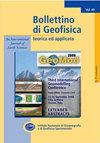One year of RST based satellite thermal monitoring over two Italian seismic areas
IF 0.7
4区 地球科学
Q4 GEOCHEMISTRY & GEOPHYSICS
引用次数: 12
Abstract
In this study, Earth’s emitted Thermal InfraRed (TIR) radiation measured from geostationary satellite sensors has been analyzed by using an original data analysis approach in order to evaluate possible space-time correlation with earthquakes (M≥4.0) occurrence. A clear definition of SSTA (Significant Sequence of Thermal Anomaly) concept is given and correlation rules are established in order to evaluate the potential of SSTAs among the parameters to be included in a pre-operational system for timeDependent Assessment of Seismic Hazard (t-DASH). On the considered time period (July 2012 June 2013) and testing areas (Italian southern Apennines and Po Plain) a false positive rate lesser than 33% has been obtained. Notwithstanding a missing rate up to 67% (mostly because of the presence of clouds preventing the continuity of observations), as confirmed by other independent studies performed on longer period of time and different geographic areas, seems to strongly support the inclusion of SSTAs [identified by the RST (Robust Satellite Technique) methodology] among the parameters whose continuous monitoring and integration with all the other relevant information available, could strongly improve our present capabilities to dynamically assess seismic hazard in a pre-operational context.在意大利两个地震区进行为期一年的RST卫星热监测
本文采用原始数据分析方法,分析了地球静止卫星传感器测量到的地球发射热红外(TIR)辐射,以评估其与地震(M≥4.0)发生的可能时空相关性。给出了显著热异常序列(Significant Sequence of Thermal Anomaly, SSTA)概念的明确定义,并建立了相关规则,以便在地震灾害时变预评估系统(t-DASH)中评估SSTA的潜力。在所考虑的时间段(2012年7月至2013年6月)和测试区域(意大利亚平宁山脉南部和波河平原),假阳性率低于33%。尽管失踪率高达67%(主要是因为云层的存在阻碍了观测的连续性),正如在较长时间和不同地理区域进行的其他独立研究所证实的那样,这似乎有力地支持将ssta[由RST(鲁棒卫星技术)方法确定]纳入其持续监测和与所有其他可用相关信息整合的参数中。可以大大提高我们目前在操作前动态评估地震危险的能力。
本文章由计算机程序翻译,如有差异,请以英文原文为准。
求助全文
约1分钟内获得全文
求助全文
来源期刊

Bollettino Di Geofisica Teorica Ed Applicata
地学-地球化学与地球物理
自引率
0.00%
发文量
0
审稿时长
>12 weeks
期刊介绍:
The "Bollettino di Geofisica Teorica ed Applicata" is an international open access journal dedicated to the publication of original papers dealing with Deep Earth Geophysics, Near Surface Geophysics, Exploration Geophysics, Borehole Geophysics, Geodynamics and Seismotectonics, Seismology, Engineering Seismology, Geophysical Modelling, Geodesy, Remote Sensing, Seismic and Geodetic Networks, Oceanography, and their application in the fields of Energy, Natural Resources, Environment and Climate, Policies and Regulations, Risk and Security, Technological Development.
 求助内容:
求助内容: 应助结果提醒方式:
应助结果提醒方式:


